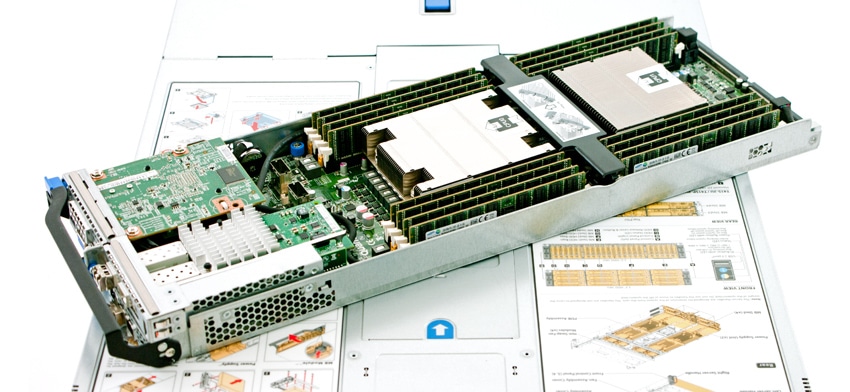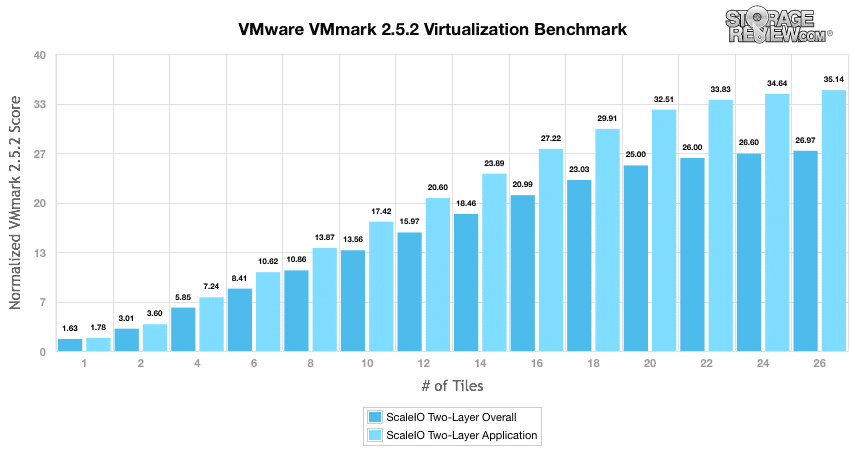We've already taken a look at how well the VxRack Node All Flash PF100 does in two key areas relating to database applications. First we saw how well ScaleIO did scaling near-linearly to full capacity with MySQL, then we honed in on SQL Server performance, purely from a transactional latency perspective. Now we turn to a well understood benchmark that emphasizes system performance for virtualized workloads with a broad base of underlying applications. VMmark stresses the entire system as the workload, referred to as tiles, scales until the storage under test either loses its ability to keep improving performance, or the compute front-end runs of steam; the latter rarely happens first.

VxRack Node (Performance Compute All Flash PF100) Specifications
- Chassis – # of Node: 2U-4 node
- Processors Per Node: Dual Intel E5-2680 V3, 12c, 2.5GHz
- Chipset: Intel 610
- DDR4 Memory Per Node: 512GB (16x 32GB)
- Embedded NIC Per Node: Dual 1-Gbps Ethernet ports + 1 10/100 management port
- RAID Controller Per Node: 1x LSI 3008
- SSDs Per Node: 4.8TB (6x 2.5-inch 800GB eMLC)
- SATADOM Per Node: 32GBSLC
- 10GbE Port Per Node: 4x 10Gbps ports SFP+
- Power Supply: Dual 1600W platinum PSU AC
VMmark Performance
VMmark tiles sit in a VM that takes up roughly 320GB of space. When testing the VxNode, we use a cluster of four Dell R730 servers to drive the load and the VxNode in 2-layer mode, acting just like a SAN. Later, we'll show the VxNode in hyperconverged (HCI) mode, doing both the compute and storage within the same chassis. We start with a one tile score, then move to two tiles and step in 2-tile increments from there. By 26 tiles the platform have either met its I/O performance limit or we start seeing our server CPUs being saturated to the point of diminishing returns.
Dell PowerEdge R730 VMware VMmark 4-node Cluster Specifications
- Dell PowerEdge R730 Servers (x4)
- CPUs: Eight Intel Xeon E5-2690 v3 2.6GHz (12C/24T)
- Memory: 64 x 16GB DDR4 RDIMM
- Emulex LightPulse LPe16002B 16Gb FC Dual-Port HBA
- Emulex OneConnect OCe14102-NX 10Gb Ethernet Dual-Port NIC
- VMware ESXi 6.0

In this case, the all-flash VxNode swims along nicely, showing even gains from start to the very end at 26 tiles. At this point while the storage has some capacity left, our compute front-end has met its saturation point. In total though, the VxNode does very nicely with the workload, showing its strength in handling a wide variety of applications all at once, even at nearly full capacity. This shouldn't be entirely surprising though to anyone who's been reading these reviews, as ScaleIO has repeatedly proven to be exceedingly capable across the board. It will be interesting to see then, as we move to HCI configuration testing, what the "tax" is to run that way vs. 2-layer. Either way you run it, the extreme flexibility of the platform continues to impress in a market where flexibility usually means a compromise in performance.
Conclusion
The VxRack Node has been showing record setting performance as we run it through our benchmarks. While it wasn’t the highest score we’ve seen to date on VMmark, the VxRack Node still had some capacity in the can once we hit our compute saturation point. The VxRack Node continues to impress on its capabilities overall. Next up we plan on seeing how well it performs in our traditional suite of synthetic benchmarks.
Other Segments of this Review:
EMC VxRack Node Review: Overview
EMC VxRack Node powered by ScaleIO: Scaled Sysbench OLTP Performance Review (2-layer)
EMC VxRack Node powered by ScaleIO: SQL Server Performance Review (2-layer)




 Amazon
Amazon